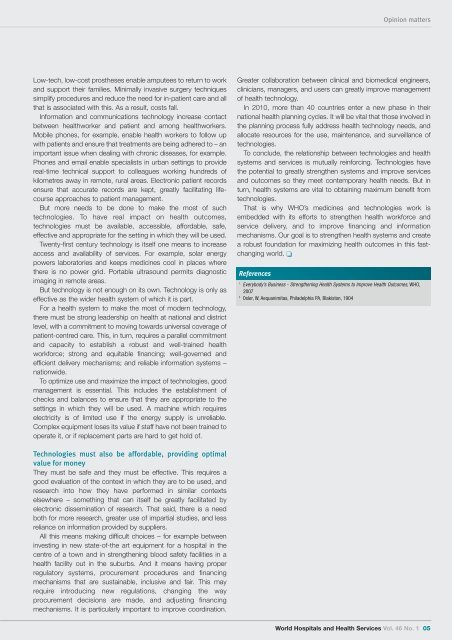vol46.1 LR.pdf - International Hospital Federation
vol46.1 LR.pdf - International Hospital Federation
vol46.1 LR.pdf - International Hospital Federation
You also want an ePaper? Increase the reach of your titles
YUMPU automatically turns print PDFs into web optimized ePapers that Google loves.
Opinion matters<br />
Low-tech, low-cost prostheses enable amputees to return to work<br />
and support their families. Minimally invasive surgery techniques<br />
simplify procedures and reduce the need for in-patient care and all<br />
that is associated with this. As a result, costs fall.<br />
Information and communications technology increase contact<br />
between healthworker and patient and among healthworkers.<br />
Mobile phones, for example, enable health workers to follow up<br />
with patients and ensure that treatments are being adhered to – an<br />
important issue when dealing with chronic diseases, for example.<br />
Phones and email enable specialists in urban settings to provide<br />
real-time technical support to colleagues working hundreds of<br />
kilometres away in remote, rural areas. Electronic patient records<br />
ensure that accurate records are kept, greatly facilitating lifecourse<br />
approaches to patient management.<br />
But more needs to be done to make the most of such<br />
technologies. To have real impact on health outcomes,<br />
technologies must be available, accessible, affordable, safe,<br />
effective and appropriate for the setting in which they will be used.<br />
Twenty-first century technology is itself one means to increase<br />
access and availability of services. For example, solar energy<br />
powers laboratories and keeps medicines cool in places where<br />
there is no power grid. Portable ultrasound permits diagnostic<br />
imaging in remote areas.<br />
But technology is not enough on its own. Technology is only as<br />
effective as the wider health system of which it is part.<br />
For a health system to make the most of modern technology,<br />
there must be strong leadership on health at national and district<br />
level, with a commitment to moving towards universal coverage of<br />
patient-centred care. This, in turn, requires a parallel commitment<br />
and capacity to establish a robust and well-trained health<br />
workforce; strong and equitable financing; well-governed and<br />
efficient delivery mechanisms; and reliable information systems –<br />
nationwide.<br />
To optimize use and maximize the impact of technologies, good<br />
management is essential. This includes the establishment of<br />
checks and balances to ensure that they are appropriate to the<br />
settings in which they will be used. A machine which requires<br />
electricity is of limited use if the energy supply is unreliable.<br />
Complex equipment loses its value if staff have not been trained to<br />
operate it, or if replacement parts are hard to get hold of.<br />
Greater collaboration between clinical and biomedical engineers,<br />
clinicians, managers, and users can greatly improve management<br />
of health technology.<br />
In 2010, more than 40 countries enter a new phase in their<br />
national health planning cycles. It will be vital that those involved in<br />
the planning process fully address health technology needs, and<br />
allocate resources for the use, maintenance, and surveillance of<br />
technologies.<br />
To conclude, the relationship between technologies and health<br />
systems and services is mutually reinforcing. Technologies have<br />
the potential to greatly strengthen systems and improve services<br />
and outcomes so they meet contemporary health needs. But in<br />
turn, health systems are vital to obtaining maximum benefit from<br />
technologies.<br />
That is why WHO’s medicines and technologies work is<br />
embedded with its efforts to strengthen health workforce and<br />
service delivery, and to improve financing and information<br />
mechanisms. Our goal is to strengthen health systems and create<br />
a robust foundation for maximizing health outcomes in this fastchanging<br />
world. ❏<br />
References<br />
1.<br />
Everybody’s Business - Strengthening Health Systems to Improve Health Outcomes, WHO,<br />
2007<br />
2.<br />
Osler, W, Aequanimitas, Philadelphia PA, Blakiston, 1904<br />
Technologies must also be affordable, providing optimal<br />
value for money<br />
They must be safe and they must be effective. This requires a<br />
good evaluation of the context in which they are to be used, and<br />
research into how they have performed in similar contexts<br />
elsewhere – something that can itself be greatly facilitated by<br />
electronic dissemination of research. That said, there is a need<br />
both for more research, greater use of impartial studies, and less<br />
reliance on information provided by suppliers.<br />
All this means making difficult choices – for example between<br />
investing in new state-of-the art equipment for a hospital in the<br />
centre of a town and in strengthening blood safety facilities in a<br />
health facility out in the suburbs. And it means having proper<br />
regulatory systems, procurement procedures and financing<br />
mechanisms that are sustainable, inclusive and fair. This may<br />
require introducing new regulations, changing the way<br />
procurement decisions are made, and adjusting financing<br />
mechanisms. It is particularly important to improve coordination.<br />
World <strong>Hospital</strong>s and Health Services Vol. 46 No. 1 05

















